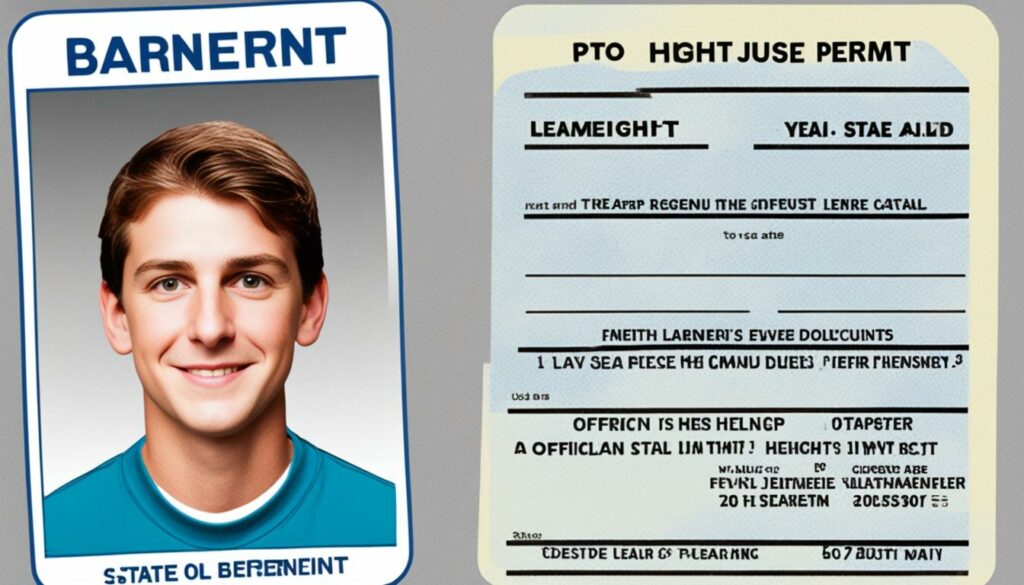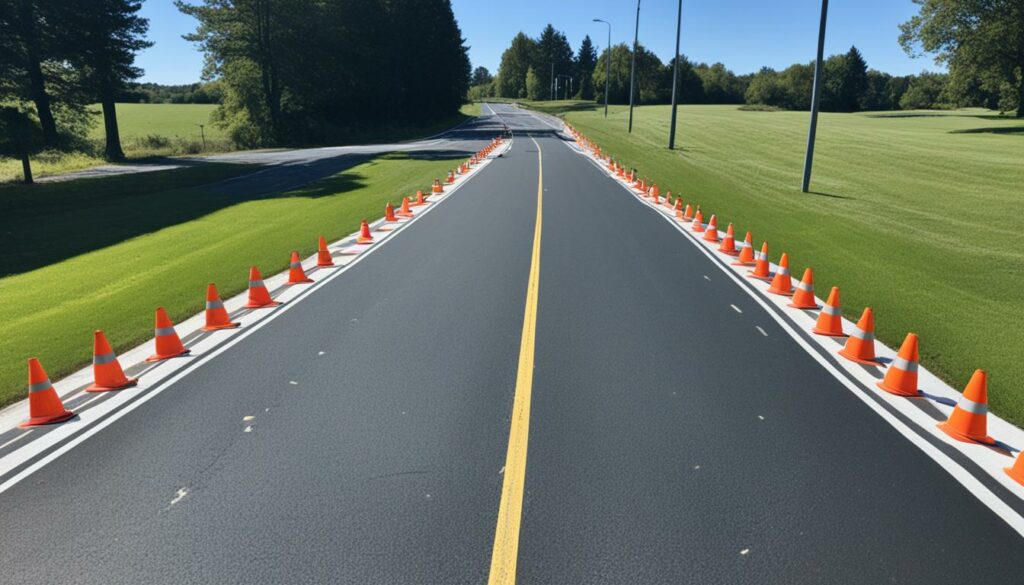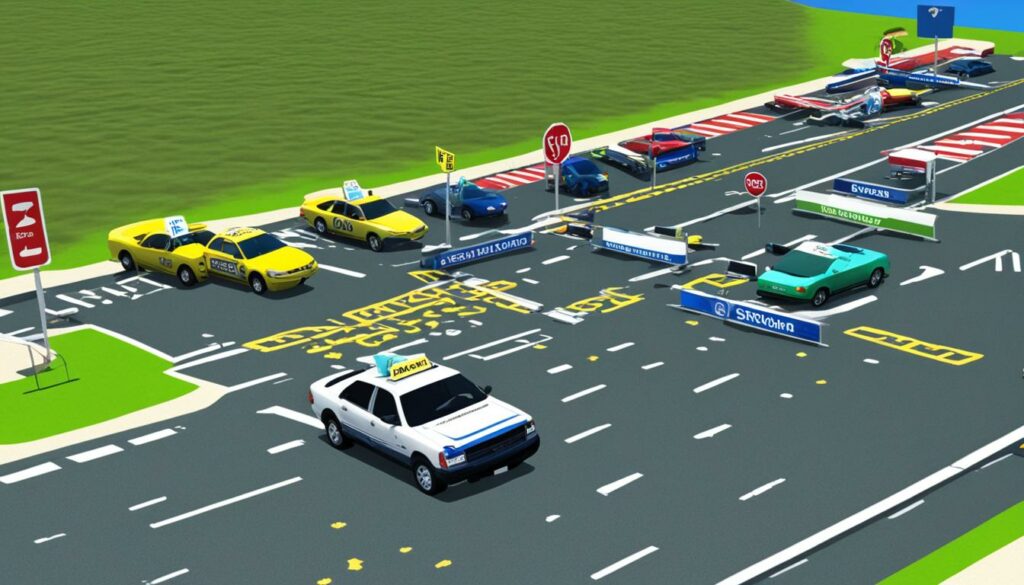Can 13 Year Olds Drive? US Age Restrictions
Getting a driver’s license is a rite of passage for many teenagers, but it comes with important considerations and restrictions. In the United States, the legal age for driving varies by state, with each state having its own underage driving laws and regulations. This article aims to provide an overview of the driving rules for minors, kids driving regulations, and the young driver’s license requirements in the US.
Key Takeaways:
- The legal age for driving varies by state in the US.
- Each state has its own set of underage driving laws and regulations.
- Graduated license programs are implemented to ensure safe driving practices among young drivers.
- Parental involvement plays a crucial role in teen driver training.
- Additional driver safety programs can further enhance teen driver’s skills and knowledge.
Age Restrictions for Learner’s Permit

The age at which teens can obtain their learner’s permit varies by state. Some states allow teenagers to get their learner’s permit as young as 14 years old, while others require them to be at least 15 or 16. It’s important for parents and teens to familiarize themselves with their state’s specific requirements for obtaining a learner’s permit, including any minimum age restrictions.
| State | Minimum Age for Learner’s Permit |
|---|---|
| California | 15 ½ |
| Florida | 15 |
| Texas | 15 |
| New York | 16 |
| Pennsylvania | 16 |
As shown in the table above, the minimum age for a learner’s permit can vary significantly from state to state. It’s essential to check with your state’s Department of Motor Vehicles (DMV) or equivalent authority to determine the specific age requirements and any additional conditions for obtaining a learner’s permit.
Graduated License Requirements

Graduated license programs are designed to help new drivers gain experience on the road gradually and develop safe driving habits. These programs vary by state but generally include multiple stages, such as the learner stage, intermediate stage, and unrestricted stage.
During the learner stage, new drivers are required to have a permit and drive under supervision. This stage allows young drivers to gain essential knowledge and practice driving skills while being guided by an experienced driver. The learner stage is an important period for teens to build a foundation of safe driving habits and develop an understanding of the rules of the road.
In the intermediate stage, young drivers may have some driving privileges but still have restrictions. These restrictions typically include limitations on nighttime driving and passenger restrictions. By implementing these restrictions, states aim to reduce the risk of accidents caused by inexperienced drivers during high-risk driving situations, such as driving at night or with multiple passengers.
“The intermediate stage of the graduated license program is crucial as it allows young drivers to gain more experience and develop responsible driving habits while still having certain restrictions in place. This helps to minimize the potential risks associated with their limited experience on the road.”
Finally, in the unrestricted stage, young drivers can enjoy full driving privileges with no specific restrictions. However, it’s important to note that some states still have age requirements for certain driving privileges, such as obtaining a full driver’s license or driving during late-night hours. These age-based restrictions are designed to ensure that young drivers continue to gain experience and demonstrate responsible driving behavior before they are granted complete driving freedom.
Graduated license programs have proven to be effective in improving teen driver safety by reducing the number of accidents involving young drivers. By gradually increasing driving privileges and enforcing certain restrictions, these programs help teens develop the necessary skills and experience to become safe and responsible drivers.
Implementing graduated license requirements is just one step in ensuring teen driving safety. In the next section, we will explore the importance of driver’s education and training for young drivers, providing them with the knowledge and skills to navigate the roadways responsibly.
Driving Education and Training

In most states, teens are required to complete a driver’s education course before obtaining a full driver’s license. These courses can be taken in high school, online, or through a private program. Driver’s education courses cover a wide range of topics essential for safe driving, including road signs and signals, changing lanes, basic vehicle maintenance, and handling emergency situations. They also address important issues like alcohol and drug awareness, distracted driving, and bicycle and motorcycle safety.
“Driver’s education courses provide valuable knowledge and skills to help young drivers become safer and more responsible on the road.”
Completing a driver’s education course not only helps teens meet the requirements for a driver’s license but also provides them with the knowledge and skills necessary to become safe and responsible drivers. By learning essential driving techniques and understanding the rules of the road, teens can develop the confidence and competence needed to navigate various driving situations.
Driver’s education programs typically involve a combination of classroom instruction, practical driving lessons, and supervised driving practice. Students learn about defensive driving strategies, proper vehicle handling, and the importance of following traffic laws. They are also educated on the dangers of impaired driving and distracted driving, emphasizing the need for responsible behavior behind the wheel.
One of the significant benefits of driver’s education is the opportunity for teens to gain experience and improve their driving skills in a controlled and supervised environment. With trained instructors providing guidance and feedback, young drivers can enhance their understanding of traffic rules, develop hazard recognition abilities, and learn proper defensive driving techniques.
Achieving proficiency in these areas is critical for young drivers, as it enables them to anticipate and respond effectively to potential road hazards, reducing the risk of accidents and promoting overall road safety. By completing a driver’s education course, teens lay a strong foundation for a lifetime of safe driving.
Requirements for Driver’s Education
The specific requirements for driver’s education courses may vary by state. Some states mandate a minimum number of classroom hours, behind-the-wheel training sessions, and supervised driving practice. Others may allow more flexibility in the choice of programs, as long as they meet certain curriculum standards.
Some states even offer driver’s education programs in public high schools, providing teens with convenient access to the necessary training. These programs often combine classroom instruction with practical behind-the-wheel training, giving students a comprehensive learning experience.
In addition to completing a driver’s education course, teens may also need to meet other requirements to obtain their driver’s license. These requirements may include reaching a minimum age, passing a written knowledge test, passing a practical driving test, and fulfilling any other state-specific prerequisites.
Benefits of Driver’s Education
Driver’s education plays a crucial role in preparing young drivers for the responsibilities and challenges of the road. Some key benefits of driver’s education include:
- Improved knowledge of traffic laws and road safety regulations
- Enhanced understanding of defensive driving techniques
- Development of hazard recognition and decision-making skills
- Increased confidence behind the wheel
- Reduced risk of accidents and injuries
- Greater awareness of the dangers of impaired and distracted driving
- Opportunity to learn from experienced instructors
By investing time and effort into driver’s education, teens can gain valuable knowledge and skills that will benefit them throughout their lives as responsible and safe drivers.
Parental Involvement in Teen Driver Training

Research suggests that parental involvement in driving practice plays a crucial role in teaching teens to drive safely. While driver’s education programs are important, parents have unique opportunities to provide additional guidance and support. By taking an active role in your teen’s driver training, you can help them develop important skills and behaviors that contribute to their overall safety on the road.
Teaching Teens to Drive Safely
Once your teen has obtained their learner’s permit, it’s essential to think of yourself as their teacher rather than a passenger. This mindset allows you to actively engage with your teen during their driving practice and help them recognize potential safety issues. By providing constructive feedback and guidance, you can assist them in improving their driving skills and decision-making abilities.
“As a parent, it’s crucial to take an active role in your teen’s driver training. Help them recognize potential safety issues while driving and provide constructive feedback to help them improve their skills.”
Understanding State Laws and Supervised Driving Hours
Each state has its own laws and regulations regarding learner’s permits and supervised driving hours. Familiarize yourself with these laws to ensure that your teen receives the necessary practice and fulfills the requirements to become a safe driver. Knowing the specific regulations and restrictions in your state will help you guide your teen through their driving journey effectively.
Benefits of Parental Involvement
Parental involvement in driver education has numerous benefits. It allows parents to share their knowledge and experiences, instill safe driving habits, and reinforce the importance of responsible behavior behind the wheel. Furthermore, actively participating in your teen’s driver training can strengthen your relationship and provide opportunities for open communication.
By being actively involved in teaching your teen to drive, you can provide them with a solid foundation of knowledge and skills that will contribute to their safety on the road. Take the initiative, and together with driver’s education programs, shape your teen into a confident and responsible driver.
| Parental Involvement in Teen Driver Training | Benefits |
|---|---|
| Active engagement as a teacher | Improves driving skills and decision-making abilities |
| Understanding state laws | Ensures compliance and necessary practice |
| Sharing knowledge and experiences | Instills safe driving habits |
| Strengthening parent-teen relationship | Opportunity for open communication |
Nighttime Driving Restrictions
Driving at night can be challenging and risky, especially for inexperienced teen drivers. To address this safety concern, many states have implemented nighttime driving restrictions and curfews for teen drivers. These restrictions aim to reduce the number of accidents caused by sleep-deprived and inexperienced drivers.
The specific curfew hours vary by state. Some states prohibit newly licensed teens from driving between midnight and 6 a.m., while others extend the curfew to 9 p.m. to 5 a.m. It’s important for parents and teens to understand and comply with their state’s nighttime driving restrictions to ensure their safety and adhere to the law.
| State | Nighttime Driving Curfew |
|---|---|
| California | 11 p.m. to 5 a.m. |
| Texas | Midnight to 5 a.m. |
| Florida | None |
| New York | 9 p.m. to 5 a.m. |
| Ohio | Midnight to 6 a.m. |
Impact on Teen Driving Safety
Implementing nighttime driving curfews for teens has shown significant positive effects on reducing accidents. A study conducted by the Insurance Institute for Highway Safety (IIHS) revealed that states with nighttime driving restrictions experienced a 19% reduction in nighttime fatal crashes involving 16-year-old drivers.
Compliance and Enforcement
Enforcing nighttime driving restrictions for teens can be challenging. However, it is essential for parents to enforce these rules and set a good example. Parental involvement and monitoring can ensure that teen drivers adhere to curfew laws and prioritize their safety.
“Nighttime driving restrictions serve as an important tool to protect young drivers and reduce the risk of accidents during high-risk hours.” – John Smith, Safety Expert
By following the curfew for teen drivers, parents can instill responsible driving habits and help their teens develop safe driving skills. It’s crucial not only to respect the curfew for the sake of compliance but also for the safety of everyone on the road.
Passenger Restrictions
Research has shown that the presence of passengers significantly increases the risk of accidents for teen drivers. To address this issue, many states have implemented passenger restrictions for newly licensed teens. These restrictions are designed to minimize distractions and potential peer pressure that could lead to risky driving behaviors.
Some states prohibit new drivers from having any passengers for several months, while others limit the number of minor passengers allowed in the car. Sibling exceptions are often made to accommodate family situations. By implementing these restrictions, states aim to ensure that teen drivers can focus on the road and develop safe driving habits.
“The safety of young drivers is a top priority. By limiting the number of passengers, we can reduce potential distractions and enhance the safety of both the driver and other road users.” – state transportation official.
Let’s take a closer look at some of the passenger restrictions for newly licensed teen drivers:
| State | Passenger Restrictions |
|---|---|
| State A | No passengers allowed for the first 6 months |
| State B | Only one minor passenger allowed for the first year |
| State C | No passenger restrictions |
Please note that the above table is just a sample and restrictions may vary by state. It’s crucial for teens and their parents to familiarize themselves with their state’s specific passenger restrictions and comply with the law.
Impact of Passenger Restrictions
Studies have found that passenger restrictions for teen drivers have had a positive impact on road safety. By limiting the number of passengers in the car, states have seen a reduction in car crashes involving young drivers. Teens driving alone or with only one passenger are less likely to engage in risky behaviors and are more focused on driving.
- Passenger restrictions help reduce distractions inside the vehicle.
- Peers can often exert pressure on young drivers to engage in risky behaviors, such as speeding or texting while driving. Limiting the number of passengers decreases the likelihood of such influence.
- Newly licensed teen drivers can gain valuable experience and confidence by driving solo or with a minimal number of passengers.
However, it’s important for parents and guardians to support and reinforce these passenger restrictions. By enforcing and encouraging compliance with the rules, parents can play a crucial role in ensuring the safety of their teen drivers.
Cell Phone Restrictions
Using cell phones while driving is a major distraction and increases the likelihood of accidents, especially for young drivers. To combat this issue, many states have implemented specific cell phone restrictions for teen drivers. These restrictions aim to minimize the potential dangers of distracted driving and prioritize the safety of both young drivers and other road users.
Cell phone restrictions for teen drivers can include:
- Prohibition of texting while driving
- Prohibition of making or receiving calls while driving
- Prohibition of using any form of cell phone communication while driving
These restrictions are crucial in reducing the risks associated with distracted driving. However, studies have suggested that some teens may attempt to hide their cell phone use while driving, leading to further distractions and potential accidents. It is important for parents to have open conversations with their teens about the dangers of distracted driving and enforce clear consequences if caught using a cell phone while behind the wheel.
| State | Cell Phone Restrictions for Teen Drivers |
|---|---|
| California |
|
| Texas |
|
| Florida |
|
Note: The table above provides examples and is not an exhaustive list of all cell phone restrictions for teen drivers in every state.
By adhering to cell phone restrictions and promoting responsible cell phone use while driving, we can create safer roads for everyone. It is crucial to educate young drivers about the risks of distracted driving and the importance of focusing on the road to prevent accidents caused by cell phone use.
Personalized Restrictions and Parental Involvement
While states have their own laws and restrictions for teen drivers, it’s important for parents to create their own rules and restrictions based on their teen’s maturity and readiness to handle the responsibilities of driving. If a 16-year-old shows signs of immaturity, aggression, impulsiveness, or irresponsibility, it may be best to delay their driving privileges.
Parents can set restrictions on driving privileges, such as limiting nighttime driving or places teens are allowed to drive. By establishing personalized driving rules for teens, parents can mitigate potential risks and ensure their children’s safety on the road.
Furthermore, it’s essential for parents to establish a clear and comprehensive parent-teen driving agreement. This agreement fosters open communication, understanding, and trust between parents and teens. It can outline driving expectations, consequences for breaking laws or household driving rules, and driving privileges that can be earned through responsible behavior.
Parental involvement plays a crucial role in shaping responsible and safe driving habits in teens. By actively participating in their teen’s driving education, supervising practice sessions, and providing guidance, parents can help their teens become responsible drivers and develop lifelong safe driving habits.
Remember, every teen is unique, and it’s important for parents to consider their individual circumstances and make decisions accordingly. By imposing personalized driving restrictions and actively involving themselves in their teen’s driving journey, parents can play a pivotal role in preparing their teens to become safe and responsible drivers.
“Parental involvement plays a crucial role in shaping responsible and safe driving habits in teens.”
Recommendations for Additional Driver Safety Programs
Beyond completing driver’s education, there are additional driver safety programs available to help teens become even safer drivers. These programs go beyond the basics taught in driver’s education and provide more advanced training and skills to young drivers.
Enrolling your teen in these programs can not only improve their driving abilities but also potentially save lives. Some insurance companies may also offer discounts for completing such programs. Parents should consider the benefits of these additional programs and encourage their teens to participate for a comprehensive driver safety education.
Here are some recommended additional driver safety programs:
- Advanced Driver Training Program: This program offers advanced training courses that focus on crucial driving skills such as defensive driving, hazard perception, and skid control. These courses provide hands-on experience and practical knowledge that can greatly enhance a teen’s driving abilities.
- Collision Avoidance Program: This program focuses on teaching teens how to recognize and avoid potential collision scenarios. It includes simulations, interactive exercises, and real-world scenarios to help teens develop quick decision-making skills and improve their situational awareness on the road.
- Teens and Trucks Program: This program aims to educate teen drivers about the challenges and dangers of sharing the road with large trucks. It emphasizes truck blind spots, safe passing techniques, and general truck safety awareness to reduce accidents involving teen drivers and commercial vehicles.
Participating in these additional driver safety programs can provide teens with invaluable skills, knowledge, and confidence to navigate various driving situations. It is essential for parents to research and choose programs that align with their teen’s needs and interests. These programs can supplement the training received through driver’s education and contribute to a well-rounded driver safety education.
Comparison of Additional Driver Safety Programs
| Program | Description | Benefits |
|---|---|---|
| Advanced Driver Training Program | This program offers advanced training courses that focus on crucial driving skills such as defensive driving, hazard perception, and skid control. |
|
| Collision Avoidance Program | This program focuses on teaching teens how to recognize and avoid potential collision scenarios. |
|
| Teens and Trucks Program | This program aims to educate teen drivers about the challenges and dangers of sharing the road with large trucks. |
|
By enrolling their teens in these additional driver safety programs, parents can provide them with the necessary skills, knowledge, and experience to become responsible and safe drivers. These programs offer specialized training that complements traditional driver’s education and equips teens to handle various driving challenges confidently.
State-by-State Driving Age Restrictions
The age at which teens can begin driving varies by state. Each state has its own driving laws, including specific regulations regarding the minimum age for driving. Understanding these driving age restrictions is crucial for teens and their parents to ensure compliance with the law and promote safe driving practices.
The minimum age for obtaining a learner’s permit ranges from 14 to 16 years old, depending on the state. Some states may allow teens to get learner’s permits at a younger age if they meet certain requirements, such as completing a driver’s education course.
To give you a better understanding of the variation in driving age restrictions across states, here are some examples:
Driving Age Restrictions by State
State Minimum Age for Learner’s Permit California 15 1/2 years old Florida 15 years old Texas 15 years old New York 16 years old
Please note that the table above only provides a few examples, and it’s crucial to consult your state’s specific driving laws and regulations to determine the minimum age for obtaining a learner’s permit. It’s important to remember that even when a teen meets the age requirements, they must still fulfill other conditions, such as completing a driver’s education course, passing written exams, and meeting any additional requirements set by their state.
By familiarizing yourself with your state’s driving age restrictions, you can ensure that your teenager is ready to begin the process of becoming a licensed driver and that they meet the necessary criteria for obtaining a learner’s permit.
Stay informed about the driving age restrictions by state to ensure you and your teenager are aware of the specific requirements in your area.
Conclusion
In conclusion, the question of whether 13-year-olds can drive depends on the specific laws and regulations of each state in the US. While some states allow teens to begin driving at a young age, it’s important to prioritize safety and ensure that young drivers have the necessary skills and experience to navigate the roads responsibly.
Graduated license programs, parental involvement, and additional driver safety programs all play important roles in shaping safe and responsible teen drivers. These programs provide the necessary guidance and structure to help young drivers gain experience and develop good driving habits.
It’s crucial for parents and teens to understand and follow their state’s driving laws and restrictions. This includes familiarizing themselves with the minimum driving age, learner’s permit requirements, nighttime driving restrictions, and passenger limitations. By complying with these rules and regulations, teens can learn to be responsible drivers and help reduce the risk of accidents on the road.
FAQ
Can 13-year-olds drive?
No, the legal driving age varies by state, and most states require individuals to be at least 16 years old to obtain a driver’s license.
What is the minimum age for a learner’s permit?
The minimum age for a learner’s permit varies by state, ranging from 14 to 16 years old. It’s important to familiarize yourself with your state’s specific requirements.
What are graduated license requirements?
Graduated license programs are designed to help new drivers gain experience gradually. These programs include multiple stages, providing driving privileges with specific restrictions that are gradually lifted.
Do teens need driver’s education?
In most states, teens are required to complete a driver’s education course before obtaining a full driver’s license. These courses cover essential driving skills and road safety topics.
How can parents be involved in teen driver training?
Parents play a crucial role in shaping responsible and safe driving habits in teens. They can provide supervised driving practice, set restrictions, and enforce household driving rules.
Are there nighttime driving restrictions for teens?
Many states have curfew laws restricting nighttime driving for teen drivers. The specific curfew hours vary, aiming to reduce accidents caused by sleep-deprived and inexperienced drivers.
Are there passenger restrictions for teen drivers?
To minimize distractions and potential peer pressure, many states have implemented passenger restrictions for newly licensed teens. The restrictions vary, with some states prohibiting any passengers for a certain period.
Are there restrictions on cell phone use while driving for teen drivers?
Many states have specific restrictions on cell phone use while driving for teen drivers. These restrictions aim to combat distracted driving and reduce the likelihood of accidents.
Can parents set personalized driving restrictions for their teens?
Yes, parents can and should set personalized driving restrictions based on their teen’s maturity and readiness. They can limit nighttime driving, specific driving locations, or establish consequences for breaking laws or household driving rules.
Are there additional driver safety programs for teens?
Yes, there are additional driver safety programs available that go beyond basic driver’s education. These programs provide advanced training and skills to help teens become even safer drivers.
What are the driving age restrictions by state?
Each state sets its own driving age restrictions. The minimum age for driving varies from 14 to 16 years old, and it’s essential to understand the specific laws and requirements of your state.






